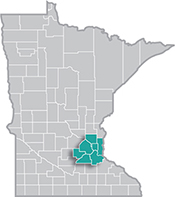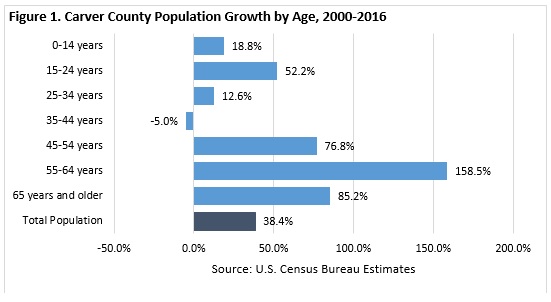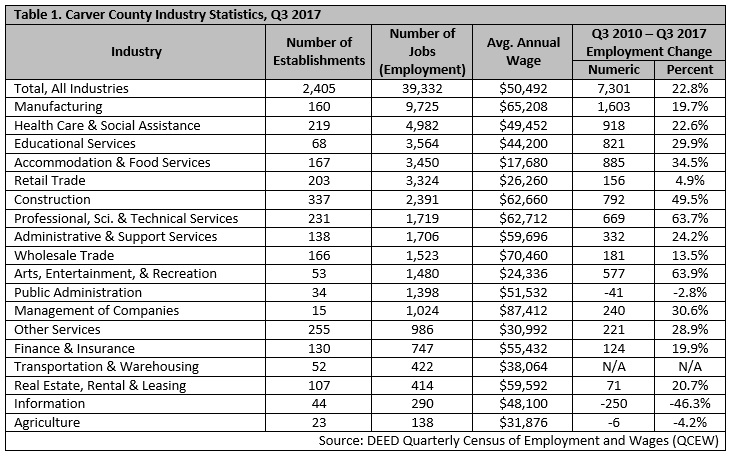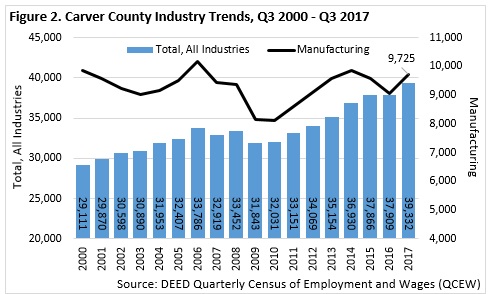 The Minneapolis-St. Paul metropolitan area is a national leader in finance, advanced manufacturing, agriculture and retailing.
The Minneapolis-St. Paul metropolitan area is a national leader in finance, advanced manufacturing, agriculture and retailing.
Medical devices, electronics and processed foods are strong suits recognized globally.
Want the freshest data delivered by email? Subscribe to our regional newsletters.
4/16/2018 10:09:32 AM
Tim O'Neill
Anchoring the western side of the Seven-County Metro Area, Carver County can be overshadowed by its neighbors to the east: Hennepin County being the largest and largest-growing county in Minnesota, and Scott County being the fastest-growing county in Minnesota. Carver County, however, has a few surprises of its own to showcase.
According to the Minnesota State Demographic Center, Carver County had a population of 110,621 people in 2016, making it Minnesota's 11th most-populated county. Chaska and Chanhassen were the county's two largest cities as of 2016, with 26,439 people and 25,448 people, respectively. Altogether, just over 90,100 people live in Carver County's 11 cities, accounting for 81.5 percent of the county's total population. Just over 10,500 people reside in the county's 10 townships, with Laketown Township being the most-populated (2,127 people). So Carver County is more populated than one might guess, being one of only 11 Minnesota counties with more than 100,000 people. This is despite being the state's second-smallest county by total land area.
And Carver County is growing rapidly. Within the last decade of available data, between annual 2006 and 2016, Carver County's total population ballooned by 16.7 percent, or about three times faster than total state growth. As such, Carver was Minnesota's second fastest-growing county, only behind Scott County just to the east. This 16.7 percent growth was equivalent to approximately 14,400 new residents, placing Carver County 9th for the state's largest-growing county during that period of time. Within the last year of available data, between annual 2015 and 2016, Carver County's population grew by 1.8 percent, equivalent to just over 1,800 people. This made it the fastest- and sixth largest-growing county in the state during that time.
It should be noted that Carver County's population is aging, a phenomenon occurring across the state and nation (Figure 1). In 2000, 7.5 percent of Carver County's population was 65 years of age and older. As of 2016, 10.0 percent of the population was 65 years of age and older. Comparatively, 14.3 percent of all Minnesotans are 65 years of age and older. So while its population is aging, Carver County does have a slightly younger population than the state overall.

Manufacturing is the name of the game in Carver County. As of the third quarter of 2017, Carver County had 2,405 establishments supplying 39,332 total covered jobs. Nearly one-quarter of these jobs were in manufacturing. In comparison, manufacturing makes up about 11 percent of Minnesota's total employment. The average annual wage for manufacturing jobs in Carver County, at $65,208, was about 29 percent higher than the average annual wage for the total of all jobs in the county, at $50,492 (Table 1). Two-thirds of Carver County's manufacturing employment was within Computer and Electronic Product Manufacturing, Miscellaneous Manufacturing, Chemical Manufacturing, and Food Manufacturing. Clearly, manufacturing is significant and diversified in Carver County, offering jobs with high wages.

While manufacturing employment has witnessed some fluctuation in Carver County since 2000, employment increased by about 20 percent, or just over 1,600 jobs, between the third quarters of 2010 and 2017. Zooming out, total employment in Carver County increased by about 23 percent, equivalent to just over 7,300 net new jobs, during that same period of time (Figure 2).

While manufacturing has added the most jobs in Carver County since the recessionary low in 2010, many other sectors have also experienced significant growth. Health Care and Social Assistance gained the second most jobs in the county between the third quarters of 2010 and 2017 (+918 jobs), while Accommodation and Food Services, Educational Services, and Construction each gained about 800 jobs or more. Professional, Scientific, and Technical Services and Arts, Entertainment, and Recreation both grew by 64 percent during this period. (Table 1).
Contact Tim O'Neill at 651-259-7401.